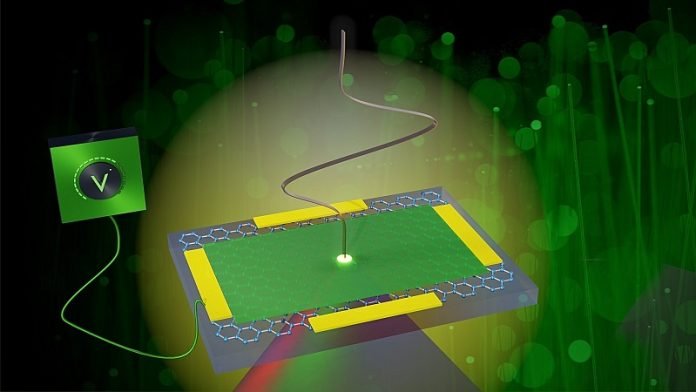
Researchers have made a remarkable breakthrough in the field of information and communication technologies.
Their recent study, published in Nano Letters, reveals the potential of graphene-based materials to efficiently convert high-frequency signals into visible light.
This groundbreaking mechanism, which is both ultrafast and tunable, opens up exciting opportunities for future technological advancements.
Signal Conversion: A Key to Technological Progress
In various technologies, such as telecommunications, converting signals from one frequency range to another is essential.
For instance, electronic devices process data that is often transmitted as optical signals through glass fibers.
To achieve even higher data transmission rates, future wireless communication systems like 6G will need to extend the carrier frequency beyond 100 gigahertz into the terahertz range. Terahertz waves reside between microwaves and infrared light on the electromagnetic spectrum.
Wireless Limitations and the Need for Conversion
While terahertz waves are capable of transporting data wirelessly, their range is quite limited.
Therefore, there is a crucial requirement for a fast and controllable mechanism to convert terahertz waves into visible or infrared light.
These converted signals can then be transported through optical fibers, enabling long-distance data transmission.
Additionally, such a mechanism holds promise for enhancing imaging and sensing technologies.
Until now, researchers have sought a material capable of upconverting photon energies by a factor of about 1000.
Recent findings indicate that Dirac quantum materials, such as graphene and topological insulators, possess a strong nonlinear response to terahertz light pulses.
This property enables the efficient generation of high harmonics—light with frequencies multiple times higher than the original laser frequency.
While previous observations had shown limited visible light emission from graphene upon infrared and terahertz excitation, the underlying physical mechanism remained elusive.
The research team has shed light on the elusive conversion mechanism and unveiled how light emission from graphene can be significantly enhanced.
They achieved this by using highly doped graphene or a grating-graphene metamaterial, which is a material with a specialized structure featuring unique optical, electrical, or magnetic properties.
The team also made a fascinating discovery: the conversion occurs swiftly, within the sub-nanosecond time scale, and it can be controlled through electrostatic gating.
The breakthrough lies in a terahertz-induced thermal radiation mechanism. When charge carriers in graphene absorb electromagnetic energy from the incident terahertz field, the energy is rapidly distributed within the material, leading to carrier heating.
Ultimately, this process results in the emission of photons in the visible spectrum, much like light emitted by a heated object.
The tunability and speed achieved in terahertz-to-visible light conversion using graphene-based materials hold tremendous potential for information and communication technologies.
This ultrafast thermodynamic mechanism could revolutionize terahertz-to-telecom interconnects and any technology that requires rapid frequency conversion of signals.
In conclusion, the collaborative efforts of scientists from renowned institutions have paved the way for groundbreaking innovation. Graphene’s ability to convert high-frequency signals into visible light brings us closer to an era of transformative technological advancements.
Follow us on Twitter for more articles about this topic.




